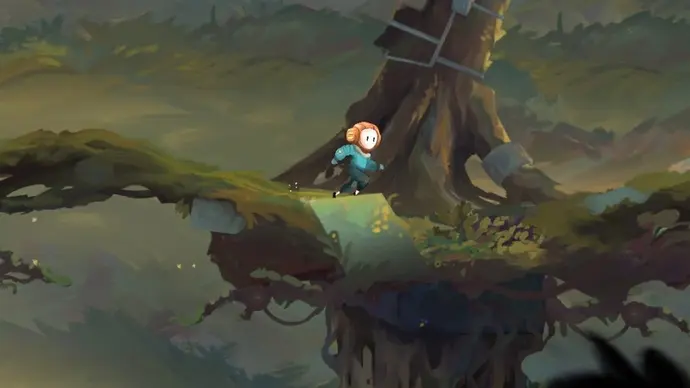
In every aspect, this platformer is flawlessly insignificant.
Out of Line’s mechanics aren’t annoyingly unclear, nor is it aggressively bad or broken. It’s not too bad to look at or listen to, and after finishing it, I felt chilled—trust me, this isn’t how I always end my platformer sessions. The platforming and puzzles are flawlessly simple, and even though it takes some getting used to your spear (more on that in a moment), there aren’t any annoying boss fights or tedious sequences to ruin your adventure, making it incredibly approachable for people who are unfamiliar with the genre or even just games in general.
However, even after completing my second game (the first taking ninety minutes, the second a little over an hour), I still don’t know what occurred in this scenario or why. Granted, there are worse ways to pass an hour, but despite the game’s exquisite simplicity and beauty, it’s really a little… blah. Despite its eerie soundtrack and hand-drawn visuals, Out of Line is neither engrossing nor monotonous. Not amazing nor horrible. Rather, it’s positioned within a passable no-man’s-land.
To be clear, there are benefits to this no-man’s-land. The experience you get and the riddles you solve in Out of Line are just not that remarkable. This presents no issue at all. It is difficult to figure out precisely what is going on because of the very light-touch narrative in which you are never given a formal introduction to the character you play as, nor do you learn about their goals or past.
In this case, what is “out of line”? That’s San, the little, pale-faced character who lies at the center of this story. San awakens in a strange land of flying cubes and monoliths, and he goes about his methodical business, attempting to escape the mechanical claws of their pursuers—huge, strangely sentient machines that pin you with the glare of their searchlights—into a factory, a forest, and the belly of rusty machinery that spews scalding steam.
Not only does San have two intriguing people that appear throughout the adventure to help San on his voyage, but he also regularly travels with similar San clones in an effort to escape this world. You cooperate to open the route forward, maybe by persuading the adorable animals that follow you into tiny vents so that you may clear out the equipment, or by stepping on a pressure plate. It feels like such a missed opportunity that a game that demands you work cooperatively with other NPCs stops short of extending that collaboration into a fully-fledged co-op mode, especially given the puzzler’s wonderful child-friendliness. However, the path forward will never feel so uncertain you’ll need a partner to help unravel the solution.
San’s spear, therefore, is what makes an otherwise ordinary experience memorable. It’s easy to mistake it for a weapon, and I attempted using it when one of the game’s few adversaries approached me, but it serves just as a traversal tool to assist San in reaching high ledges and hitting buttons that are out of reach. It’s not always the easiest thing to maneuver, especially since you occasionally have to throw it quickly and accurately to escape, but since the puzzles are typically straightforward and uncomplicated, it’s rarely frustratingly so. It can also be jammed into the ground at specific points to use as a lever.


Although the set-pieces get somewhat more elaborate and ambitious as the tale goes on—I found the rope bridges San can eventually create with their spear to be really cool—the challenges don’t change nearly enough to keep the gameplay feeling new in a game this short. The majority of puzzle sequences seem like repurposed versions of their predecessors.
Still, it’s quite gorgeous. Everything is painted by hand, including San’s tiny, black eyes, their friends, and the actual world they explore. This results in a decent, if not very wide, variety of levels and locations. I never did figure out why those inquisitive mechanical claws detested me so much, or why the magical flying cubes gathered on the blue-hued tree, but I guess it doesn’t matter. Out of Line is more about showing than it is about saying; its leisurely, dreamy soundtrack and its enigmatic, impressionistic paintings are ours to interpret anyway we like. The only thing I wish it had was more difficult riddles and mysteries to keep me interested; there’s really little need to keep playing to find additional endings or secrets, and even the collectibles can be quickly emptied out on your first trip.

Therefore, even if I did like my short time with it, Out of Line is mostly all style and little content, so even die-hard aficionados of the genre could find it difficult to recommend without reservation. Still, I believe it’s an ideal introduction game for younger or less experienced gamers. Apart from a few repulsive crabs that follow you throughout the journey and a few easy chase scenes, there isn’t any immediate danger, blood, or foul language—in fact, there isn’t any language at all—and there aren’t many, if any, puzzles that should keep even novices stuck for a long time.
Although it won’t quench your need for Limbo or Inside platforming, Out of Line is still a fun way to pass the time in the evening.